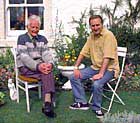

[Borders history]
![]()
history
 |
ballad singer Willie Beattie entertains presenter Tony Robinson |
For over 350 years up to the end of the 16th century, various families -- clans -- argued over their rights to a stark stretch of land on the border of Scotland and England. The members of these families -- who were great riders with 'lang spear' and 'steill bonnet' -- became known as the Reivers.
The 'border lands' stretch from the Solway Firth in the west to the Northumbrian and Berwickshire coast in the east, and comprise the Cheviot Hills and parts of the Southern Uplands and the Pennines. They are riven by the waters of the Nith, the Annan, the Esk, the Teviot, the Tweed and by Redesdale, Coquetdale, Tynedale and, of course, Liddesdale, scene of many of the bloodiest events of the Reiving years.
The border remained fairly constant after the middle of the 12th century, and both the English and Scottish governments actively encouraged settlement, offering low rents and land in exchange for, when needed, military help. As a result, the area became well populated, but with the consequence that the poor inhospitable land was unable to support the growing community. This in turn caused unrest and unruly behaviour. Theft became endemic on both sides of the border, the local families believing -- given their need to earn a living -- that their 'reiving' was lawful trading and not theft.
In an attempt to regulate this thieving and stealing, in 1249 the two governments reached an agreement (the Law of the Marches) to divide the area into three Marches -- East, West and Middle - with these being subdivided into Scottish and English. Each March was administered by a warden. The Scottish West March -- one focus of the Time Team programme -- included Eskdale, Ewesdale and Wauchopedale.
Between the Scottish and English Middle Marches was an area of unclaimed land known as the 'Debateable Land', about 12 miles long and between 3.5 and 5 miles wide. It had become the custom for both Scots and English to pasture their sheep and cattle on this land, but as soon as anyone attempted to build on it, disputes arose. This area soon became a sanctuary for fugitives, outlaws and murderers who used the area as a base for their marauding, attacking Scots and English alike.
George MacDonald Fraser -- perhaps best known for his Flashman novels -- wrote in his history of the Border Reivers, The Steel Bonnets :
The great border tribes of both Scotland and England feuded continuously among themselves. Robbery and blackmail were everyday professions; raiding, arson, kidnapping, murder and extortion an accepted part of the social system.
While the monarchs of England and Scotland ruled the comparatively secure hearts of their kingdoms, the narrow hill land between was dominated by the lance and the sword. The tribal leaders from their towers, the broken men and outlaws of the mosses, the ordinary peasants of the valleys, in their own phrase 'shook loose the Border'. They continued to shake it as long as it was political reality, practising systematic robbery and destruction on each other. History has christened them the Border Reivers.
In the story of Britain, the Border Reiver is a unique figure. He was not part of a separate minority group in his area; he came from every social class. He was an agricultural labourer, or a small-holder, or a gentleman farmer, or even a peer of the realm, a professional cattle rustler, a fighting man and a guerrilla soldier of great resource to whom the arts of theft, raid, tracking and ambush were second nature. He was also a gangster organised on highly professional lines, who had perfected the protection racket three centuries before Chicago was built. He gave blackmail to the English language ...
These were Borderers before they were either Scots or English; their allegiance was first to the family, the surname, not to the Crown; they would marry, or steal, or kill among their own countrymen as well as across the border. 'They are a people,' wrote a harassed official in 1583, 'that will be Scottishe when they will, and Englishe at their pleasure.' They lived apart.
Throughout the Reiving years, travel was a dangerous business. Strangers met with suspicion, fear and hostility. The traveller had to move cautiously by day, always seeking shelter before nightfall and rarely finding a welcome. It was as well to be careful -- after all, these times also gave us the word 'bereavement'.
To put a stop to this mayhem, James VI of Scotland -- who, on the death of Elizabeth, became James I of England -- called for an end to hostilities, and in 1603, the year he ascended the English throne, he proclaimed that the area should be divided. The result was a five-mile-long stone and earthen wall known as Scots Dyke, part of which can still be seen today near Canonbie.
However, despite this arrangement, the cross-border raids continued until the mid-17th century.
 |
the reivers' cycle route |